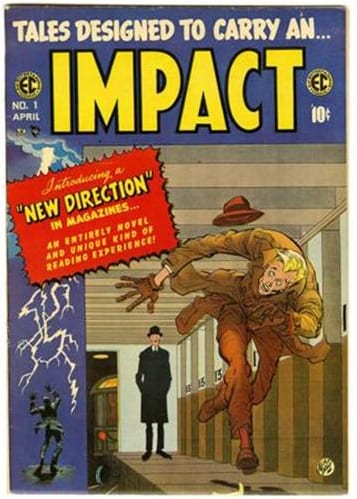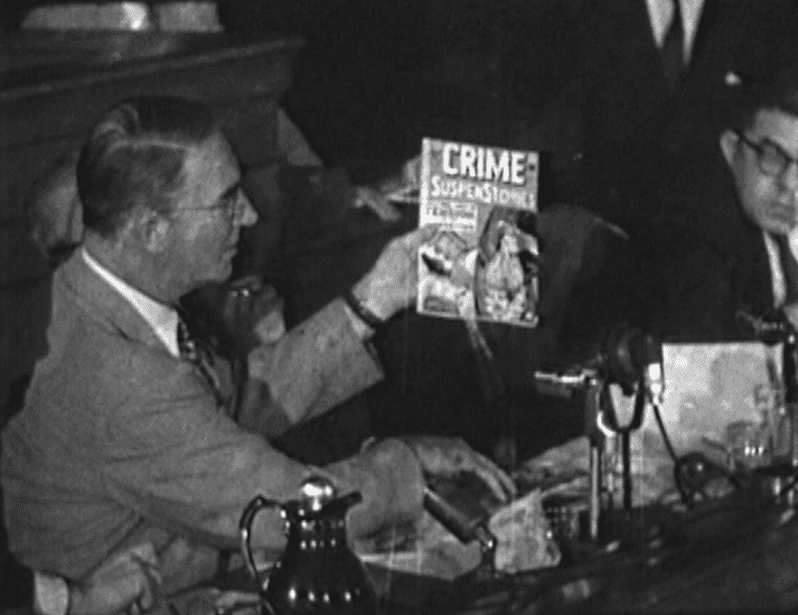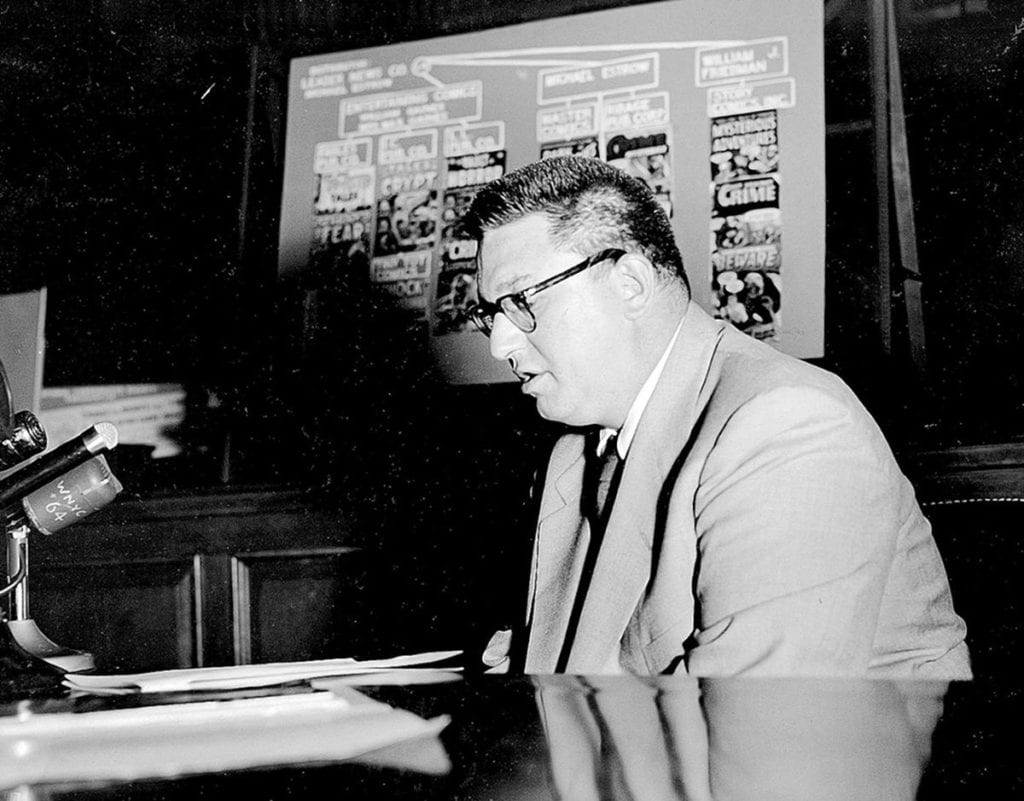Or The Comic that Killed EC
Even without being an avid comic book reader, many people can still recognize some ‘important’ comics. These will, more often than not, fall into the ‘First Appearance’ category, whether that relates to a character or a creator. Detective Comics #27, for example, with its iconic image of Batman swinging across the city, a criminal in his arms; or The Amazing Spider-Man #298 which contains the first appearance of Eddie Brock and Todd McFarlane’s first issue on art duties.
These types of comics are fan favorites and often become highly collectable because of the desire to own a part of history. However, some comics have historical significance for other reasons, due to their links with social or controversial events. These comics might not have as far reaching recognition as others, but their significance is just as important in the foundation of the industry.
Take for example, Impact #1, published by EC Comics in April 1955. It might not be a comic most people are familiar with but the anthology contains a story by Bernie Krigstein, called Master Race. The strip is one of the most visually stunning and thematically important comics ever published. It is one of the first American comics to directly reference the holocaust.
Another EC comic, Crime SuspenStories #22, holds a place in comic book history for a slightly different reason. Unlike Impact #1, the contents and creators of this comic are not of particular interest but what the comic was used for has cemented it as a significant and collectable publication.

Juvenile Delinquency
The early 1950’s was a prosperous time for the comic industry in America. There were a number of publishers putting out hundreds of titles, selling upwards of 26 million comics per month.
These were often widely available, sold on newsstands and in grocery stores all across America. Relatively cheap, with cover prices of 10 cents per comic, it was easy for young readers to get their favorite titles every month. Publishers like EC Comics were thriving, in part because of the range of comics that they released but also because of the content. Crime and horror comics were big business and EC Comics were dedicated to releasing the best titles they could.
Comics such as Tales From The Crypt and Weird Fantasy are infamous and have as much of a following today as they had back in the 1950’s. The creators who worked on the titles were often at the top of their game and no-one, from writer and artist to editor and publisher, were afraid to push the boundaries of the stories they told.
However, there was a storm brewing, one that would decimate the comic industry. Towards the end of the 1940’s not everyone was happy about the comics that were circulating around the country. There was a growing concern about the contents of some horror and crime comics and the detrimental effect that they were having on children. Organizations were beginning to question if the rise in juvenile delinquency could be tied with the spread of the cheap comics that were popular amongst the younger generation.
Two articles published in 1948 kicked off the organized backlash against comics. Both articles were written by Fredric Wertham who became famous for writing The Seduction of the Innocent, a publication that arguably did more damage to the image of comics than any other published work. The two articles led initially to the formation of the Association of Comics Magazine Publishers, which failed to regulate content and had almost no effect at the time.
This initial failure fueled Wertham’s mission to fight inappropriate content and led to the book mentioned above and a US Congressional hearing into the effect of comics on Juvenile Delinquency. The hearing did not go well for the industry, leading to the formation of the Comics Code Authority and ultimately the downfall of EC Comics.

Suspenseful Stories
So, what role did Crime SuspenStories #22 play in all of this?
When the 1954 Senate Subcommittee Hearings began in New York, it was clear from the outset that an element of scapegoating was taking place. Testimony was presented and the Committee asked questions of each witness, however the committee member’s were more inclined to ‘grill’ those arguing against the motion that comics were an unhealthy influence on the readers.
The first speaker on April 21 was Richard Clendenen, the executive director of the Senate Subcommittee To Investigate Juvenile Delinquency. He opened with a brief description of the comic publishing industry with some figures based on distribution and sales. He then went on to give some examples of the types of comics that the Subcommittee were concerned about. These comics included Black Magic Magazine, Mysterious Adventures, The Haunt of Fear, and Shock SuspenStories.
It was stated categorically in the opening statements that no-one wanted to infringe upon freedom of speech but content deemed unsuitable needed to be regulated. In the case of Crime SuspenStories #22, the committee barely got past the cover.
During the hearings William Gaines, EC Publisher and Co-Editor, voluntarily took a stand against the committee, despite recommendations to the contrary. His opening was defiant and bold. He was full of bravado, despite a lack of sleep and suffering from amphetamine withdrawal. Unfortunately for Gaines, the Committee had already heard Dr Wertham’s damnation of comics and their evil effects on the youth of America. As the publisher’s testimony continued he was drawn into lines of reasoning that would ultimately bring down the industry.
Chief Council Herbert Beaser asked the question, “Is there any limit you can think of that you would not put in a magazine because you thought a child should not see or read about it?”
Gaines replied by saying his limits were ‘the bounds of good taste’. It was at this point that Senator Estes Kefauver brought out a copy of Crime SuspenStories #22.
The cover of the comic shows the torso of a man, in one hand holding a bloody axe and the other a disembodied head of a woman. In the background a woman’s body lays on the floor, only her legs are visible. Senator Kefauver appears shocked by the comic he holds and asks Gaines if he considers it in good taste. Gaines’ reply is magnificent, in one respect, but completely damning in another. It is as if he is mocking the Committee and the Senator in an attempt to defend his art. Do you think the comic is in good taste?
Gaines: “Yes sir, I do, for the cover of a horror comic. A cover in bad taste, for example, might be defined as holding the head a little higher so that the neck could be seen dripping blood from it, and moving the body over a little further so that the neck of the body could be seen to be bloody.”

Justifiable Self-Destruction
Gaines makes, in his eyes, valid points. In fact, these suggestions had been made to the artist, Johnny Craig, before the final artwork had been submitted. However, the exchange and the ‘horrific’ cover made national headlines and it was deemed that publishers were defending disturbing content that would warp a child’s mind. A single cover for a single comic spelled the end of crime and horror comics for an entire generation, toppling a hefty chunk of the industry with it. Fearing Government regulation, the comics industry backed down, created the Comics Code Authority, and set the bar for appropriateness too high for a large number of comics to reach.
One man’s belief in the work he published, and a single horror comic cover, changed the course of comic book history with ripples still being felt today. The next time someone asks you about an important comic book, remember Crime SuspenStories #22 and the massive change it brought to a multi-million dollar industry.
For further reading on the Senate Subcommittee Hearings please see the History of Comics Censorship on the cbldf.org website, Transcripts from the hearings at https://www.thecomicbooks.com/1954senatetranscripts.html and actual recordings at https://www.wnyc.org/story/215964-senate-subcommittee-juvenile-delinquency/


